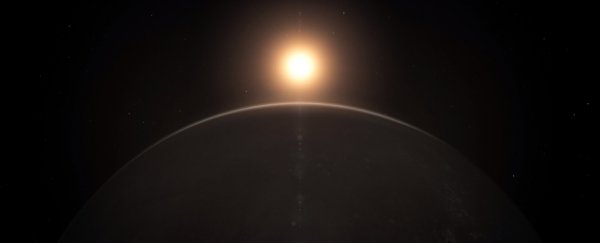At just 11 light-years from our Solar System, a newly discovered exoplanet is the second-closest we've ever found that's temperate enough to potentially host and sustain life.
Earth-sized planet Ross 128 b orbits inactive red dwarf Ross 128 in the system's Goldilocks zone. This means it ticks all the initial habitability boxes: it's probably rocky, not gaseous; and it's at a distance from its star that means the temperature could be hospitable to life as we know it.
It was found using the European Southern Observatory's High Accuracy Radial velocity Planet Searcher (HARPS) in Chile - the most precise instrument of its kind. And it took researchers a long time to nail down.
"We started to observe this star in July 2005," astronomer Nicola Astudillo-Defru of Geneva Observatory told ScienceAlert.
"Since 2013, our monitoring started to be more intense, and only after acquiring 157 observations was the signal of the planet strong enough to be detected."
Here's what we know about Ross 128 b so far. It's 1.35 times the mass of Earth. This means it's most likely a rocky planet since - as far as we know at least, gas planets tend to be giants.
That's the other point in favour of Ross 128 b being a rocky planet: it's relatively close to its host star. In fact, it's 20 times closer to its star than Earth is to the Sun, and completes an entire orbit in 9.9 days.
Why isn't it too hot for life? Ross 128 is a cool, faint red dwarf. It emits less radiation than our yellow Sun, so Ross 128 b receives only about 1.38 times more irradiation than Earth. Its equilibrium temperature is estimated to be between -60 and 20 degrees Celsius (-76 to 68 degrees Fahrenheit).
In terms of flares, the star is also much quieter than other red dwarfs - such as Proxima Centauri, the red dwarf around which orbits our closest extrasolar planetary neighbour, Proxima Centauri b. So conditions on Ross 128 b are likely to be much more stable.

The researchers were able to figure all this out using the radial velocity method of planet detection - which is different to the transit method we usually hear about - and shows this technique still has a whole lot of potential for finding new exoplanets.
The transit method is one of the most commonly used in the planet-hunting kit. It determines the presence of an exoplanet based on its transits in front of its host star. When the planet orbits between the telescope and the star, the star's light appears to dim.
This is how the Kepler spacecraft detects exoplanets, and it's found 2,337 confirmed exoplanets this way. This makes the method the most productive way of finding exoplanets, based on sheer numbers.
But there is a significant weakness in the transit method. It requires that the planet's orbit be lined up in such a way that it will actually pass between the telescope and the star.
For exoplanets that aren't aligned in this way, the radial velocity of the host star can be used to infer the presence of an exoplanet.
Basically, as a planet orbits a star, it doesn't stay fixed in place. The planet exerts a very slight gravitational force on the star, too, causing it to move in a small circle or ellipse.
This means a star's distance from Earth changes slightly - and, as it does so, its light spectrum changes. As it moves closer to Earth, it is slightly bluer; as it is farther, it becomes slightly redder. This is called the Doppler shift, and it's what the radial velocity method measures.
It's painstaking work. Over a decade of monitoring by the HARPS instrument went into the discovery of Ross 128 b.
"Even if the star is close to us, we need to deal with spurious effects in data," Astudillo-Defru told ScienceAlert.
"For example, the dynamic of the stellar surface introduces signals in data, when the amplitudes in the signals produced by the star and planets are comparable, it is still difficult to disentangle both signals."
"We started to observe this star in July 2005. Since 2013, our monitoring started to be more intense, and only after acquiring 157 observations was the signal of the planet strong enough to be detected."
What we don't know yet is whether Ross 128 b has an atmosphere - that is something that is best determined by the transit method. But the Extremely Large Telescope, currently under construction and due to see first light in 2024, will be powerful enough to image the planet directly, and hopefully detect the biomarkers that indicate life.
"We have some ideas about which biomarkers to search for. Of course it is only based on what we know on Earth," Astudillo-Defru explained.
"The first discovery of an exoplanet around a Sun-like star (51 Peg b) was an enormous surprise because it was not expected to find such a planet orbiting at such a distance from its star. Similarly, maybe we will find species in the atmosphere of Ross 128 b that indeed are different biomarkers than the ones in Earth (harder to prove), so we will continue… learning."
The paper, "A temperate exo-Earth around a quiet M dwarf at 3.4 parsecs," has been published in the journal Astronomy & Astrophysics.
